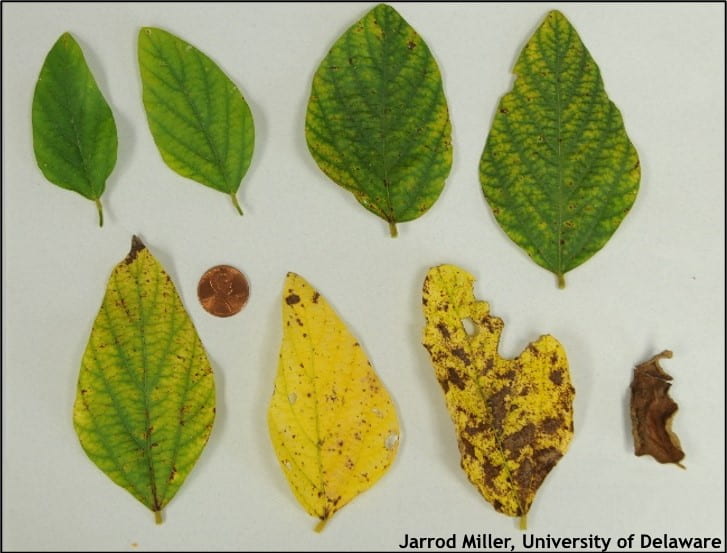Amy Shober, Extension Nutrient Management and Environmental Quality Specialist, ashober@udel.edu; Jarrod O. Miller, Extension Agronomist, jarrod@udel.edu; Mark Reiter, Associate Professor and Extension Specialist, Soils and Nutrient Management, Virginia Tech, mreiter@vt.edu
Soybean is susceptible to manganese (Mn) deficiency, especially when grown on sandy, low organic matter soils like we have in Delaware. Soil Mn availability is a function of both Mn concentration and soil pH. Soil Mn converts to unavailable forms as soil pH increases. So when soil pH starts creeping above 6.2, we can start to see Mn deficiency symptoms. While Mn deficiency can be widespread across the field, we can also see Mn deficiency symptoms in small pockets in a field, often occurring after liming. Deficiency symptoms can be prevalent in areas where lime applications overlapped or where the soil is sandier than the general field; thereby changing pH more quickly and becoming higher than soils with more clay, loam, and/or organic matter. Manganese deficiencies may also reveal themselves with dry soil conditions like we have seen this summer (especially when soils were tilled soils) because soil Mn also becomes less available to plants. Interestingly, Mn deficiencies are less likely in areas of the field that stay wetter (e.g., compacted wheel tracks, field ditches) as wetter soils are less oxygenated, promoting plant available forms of Mn (as seen in the photo below).
This image shows areas of the field where the soybeans that were growing in a field ditch (yellow arrow) showing less Mn deficiency symptoms than areas that have better tilth.
Before planting, the likelihood of soil Mn deficiency can be predicted based on the Mehlich 3 soil test Mn concentration and the soil pH. These values are used to calculate the soil Mn availability index (MnAI); soil test results from the University of Delaware Soil Testing Program will include the MnAI value. If you use a commercial laboratory that doesn’t report MnAI, you can calculate the index. If your MnAI is > 35, Mn deficiency is unlikely. In contrast, if the MnAI is <25, Mn deficiency is likely and your crop would likely benefit from a prophylactic application of Mn. However, if the MnAI falls between 25 and 35, you might want to scout fields now to look for signs of Mn deficiency to check for hidden hunger (i.e. no visual symptoms) using a tissue test.
Manganese is an immobile plant nutrient, meaning that plants cannot move Mn to new growth. As a result, Mn deficiency appears on the newest growth. The most common symptom of Mn deficiency is interveinal chlorosis (i.e., yellowing), the same symptom that may present with other issues, like zinc or iron deficiency or soybean cyst nematode. Therefore, it is prudent to look for multiple pieces of evidence before declaring Mn deficiency. Inspect the root systems to rule out nematode problems or herbicide injury from previous crops. Look for shortened and rosetted stems, which are indicative of zinc deficiency. Also, look for the presence of necrotic spots — another symptom of Mn deficiency. Ultimately, Mn deficiency is best confirmed with results of a tissue test. A tissue test can even identify a hidden Mn deficiency in fields with a history of Mn deficiency or with borderline MnAI values. Even if you determine there is a Mn deficiency by sight, taking a tissue sample can confirm your suspicions and help you plan for future crops.
Manganese deficiency will present as interveinal chlorosis on new leaves, sometimes with necrotic spots.
Should you identify a Mn deficiency, there is still time to apply Mn to correct the deficiency in double-cropped beans. Foliar applications are the most beneficial, since the nutrient is taken up more quickly through the plant tissue. Also, if the soil pH is too high, any soil applications of Mn will likely not help your plants. Apply 0.5 to 1 lb chelated Mn (elemental basis) or 1 to 2 lb of inorganic Mn oxide or Mn sulfate (elemental basis) per acre foliarly prior to flowering. More than one application may be required to correct a severe deficiency. Many Mn products may recommend lower rates of Mn, but lower rates are meant for maintenance and not to correct deficiencies. Choose EDTA chelated Mn formulations when mixing with glyphosate, as use of Mn oxide or Mn sulfate may reduce the efficacy of glyphosate. As always, check compatibility of your Mn products with any other pesticide that you may add to the tank mix.
Note that we only recommend foliar applications if there is evidence of a Mn deficiency (e.g., soil test results, tissue analysis, or visual symptoms). Manganese is needed in small amounts by the plant, so over application (e.g., spraying higher rates or applying Mn when soil pH is below 5.9) can lead to Mn toxicity problems.


